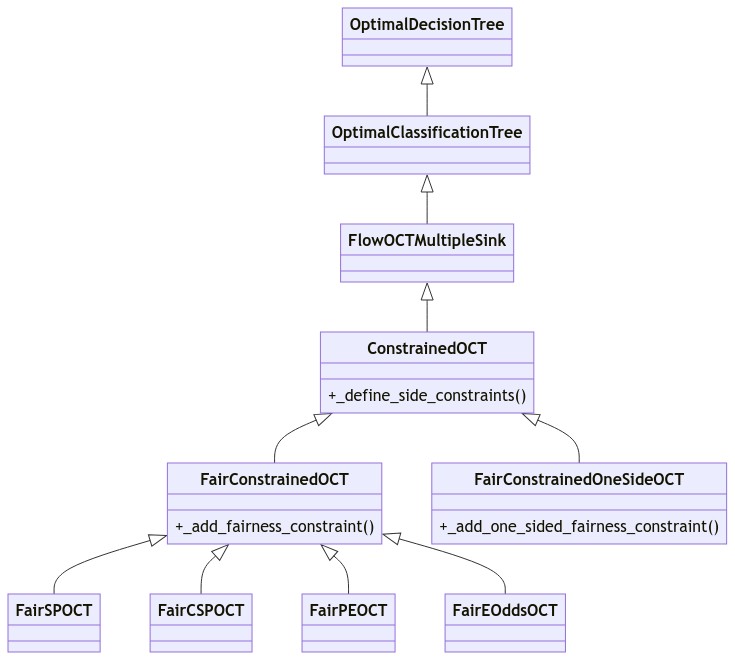Adding side constraints to optimal classification trees¶
This document aims to demonstrate how users can leverage the object-oriented structure of the ODTlearn package to create optimal classification trees with side constraints. In particular, we will show how to construct an optimal classification tree with a one-sided fairness constraint instead of a two-sided fairness constraint used in FairSPOCT, FairCSPOCT, FairPEOCT, and FairEOddsOCT classes.
The figure below shows a simplified class structure for optimal classification trees with fairness constraints. The ConstrainedOCT class includes an abstract method _define_side_constraints() which will be added to the optimization problem on top of the tree structure, flow, and arc constraints declared by the FlowOCTMultipleSink class. The FairConstrainedOCT class provides a method for adding a two-sided fairness constraint, and the classes that inherit from it contain methods calculating the particular fairness notion of interest. However, for our example, we want a one-sided bound instead of a two-sided bound. In other words, we want the difference between two groups to not exceed a desired value rather than be bounded in absolute value.

To achieve this goal of creating an optimal classification tree with a one-sided fairness constraint, we will create a new class called FairConstrainedOneSideOCT that will inherit from ConstrainedOCT, and we will define a new method _add_one_sided_fairness_constraint() as shown in the class diagram below. While it is likely feasible to modify the FairConstrainedOCT class to allow users to specify whether they want a one-sided or two-sided fairness constraint when they initialize one of the four different Fair*OCT classes, such an approach leads to duplicated code and increased code complexity which makes future modifications to the code more complicated.

First we need to initialize the FairConstrainedOneSideOCT class and have it inherit from ConstrainedOCT.
class FairConstrainedOneSideOCT(ConstrainedOCT):
def __init__(
self, solver, _lambda, depth, time_limit, num_threads, verbose
) -> None:
super().__init__(solver, _lambda, depth, time_limit, num_threads, verbose)
Next, we will define our _add_one_sided_fairness_constraint() method which will take as arguments values of the fairness metric of interest for two groups  and
and  .
.
def _add_one_sided_fairness_constraint(self, p_df, p_prime_df):
count_p = p_df.shape[0]
count_p_prime = p_prime_df.shape[0]
constraint_added = False
if count_p != 0 and count_p_prime != 0:
constraint_added = True
self._solver.add_constr(
(
(1 / count_p)
* self._solver.quicksum(
self._solver.quicksum(
self._zeta[i, n, self._positive_class]
for n in self._tree.Leaves + self._tree.Nodes
)
for i in p_df.index
)
- (
(1 / count_p_prime)
* self._solver.quicksum(
self._solver.quicksum(
self._zeta[i, n, self._positive_class]
for n in self._tree.Leaves + self._tree.Nodes
)
for i in p_prime_df.index
)
)
)
<= self._fairness_bound
)
return constraint_added
After our one-sided constraint method has been defined, we still need to define the remaining abstract methods: _define_objective(), fit(), and predict(). We omit these functions for this notebook, but for the interested reader, they would largely mirror the methods defined in FairConstrained.
With the FairConstrainedOneSidedOCT class completed, we can now define child classes for a fairness notion of interest. For this example, we will create a class for an optimal classification tree with a one-sided statistical parity constraint.
class FairOneSideSPOCT(FairConstrainedOneSideOCT):
def __init__(
self,
solver,
positive_class,
depth=1,
time_limit=60,
_lambda=0,
obj_mode="acc",
fairness_bound=1,
num_threads=None,
verbose=False,
) -> None:
"""
An optimal classification tree fit on a given binary-valued data set
with a one-sided fairness side-constraint requiring statistical parity (SP) between protected groups.
Parameters
----------
solver: str
A string specifying the name of the solver to use
to solve the MIP. Options are "Gurobi" and "CBC".
If the CBC binaries are not found, Gurobi will be used by default.
positive_class : int
The value of the class label which is corresponding to the desired outcome
depth : int, default = 1
A parameter specifying the depth of the tree
time_limit : int, default= 60
The given time limit (in seconds) for solving the MIO problem
_lambda : float, default = 0
The regularization parameter in the objective. _lambda is in the interval [0,1)
obj_mode: str, default="acc"
The objective should be used to learn an optimal decision tree.
The two options are "acc" and "balance".
The accuracy objective attempts to maximize prediction accuracy while the
balance objective aims to learn a balanced optimal decision
tree to better generalize to our of sample data.
fairness_bound: float (0,1], default=1
The bound of the fairness constraint. The smaller the value the stricter
the fairness constraint and 1 corresponds to no fairness constraint enforced
num_threads: int, default=None
The number of threads the solver should use. If None, it will use all avaiable threads
"""
super().__init__(solver, _lambda, depth, time_limit, num_threads, verbose)
self._obj_mode = obj_mode
self._positive_class = positive_class
self._fairness_bound = fairness_bound
def _define_side_constraints(self):
# Loop through all possible combinations of the protected feature
for protected_feature in self._P_col_labels:
for combo in combinations(self._X_p[protected_feature].unique(), 2):
p = combo[0]
p_prime = combo[1]
p_df = self._X_p[self._X_p[protected_feature] == p]
p_prime_df = self._X_p[self._X_p[protected_feature] == p_prime]
self._add_fairness_constraint(p_df, p_prime_df)
The process for other notions of fairness including conditional statistical parity, equalized odds, and predictive equity is similar but with different formulas for calculating  and
and  . For additional details on how
. For additional details on how  and
and  as well as further information about the fair optimal classification tree MIO formulation, please see the FairOCT paper: https://arxiv.org/abs/2201.09932.
as well as further information about the fair optimal classification tree MIO formulation, please see the FairOCT paper: https://arxiv.org/abs/2201.09932.